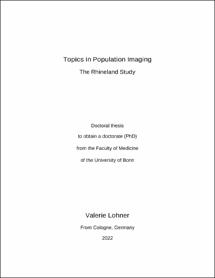Topics in Population ImagingThe Rhineland Study

Topics in Population Imaging
The Rhineland Study

| dc.contributor.advisor | Breteler, Monique M.B. | |
| dc.contributor.author | Lohner, Valerie | |
| dc.date.accessioned | 2022-07-29T11:45:45Z | |
| dc.date.available | 2023-08-01T22:00:20Z | |
| dc.date.issued | 29.07.2022 | |
| dc.identifier.uri | https://hdl.handle.net/20.500.11811/10118 | |
| dc.description.abstract | Population imaging is the large-scale data acquisition and analysis of medical images in population-based cohorts. When combined with other data acquired in the cohort, it provides the unique potential to characterise disease burden and identify persons at risk. In setting up new population imaging studies, one has to address several challenges, such as the minimisation of selection bias and how to deal with incidental findings. Population imaging enables the investigation of a wide range of topics of interest, including age-related diseases as cerebral small vessel disease (SVD), of which white matter hyperintensities (WMH) are the archetypical example. In the first part of my thesis, I focus on how to conduct population imaging in an ethically and valid manner. I performed my research in the context of the Rhineland Study. I successfully broadened standard magnetic resonance imaging (MRI) eligibility criteria, allowing eligible participants with medical implants without MRI safety certificate, tattoos and permanent make-up to undergo 3 Tesla MRI. None of the participants reported any adverse events, suggesting that most medical implants, tattoos, and permanent make-up are MRI suitable. Including participants with such indications is crucial to reduce selection bias, thereby improving generalisability of research findings. The handling of incidental findings, i.e., if and which abnormalities should be reported back to participants, requires insights in the frequency and clinical relevance of the finding. I investigated the prevalence and clinical relevance of incidental findings on neuroimaging in the Rhineland Study. While we observed incidental findings in almost 25 % of the participants, only 5 % of the detected abnormalities required diagnostic work-up. In the second part of my thesis, I examine the effect of biological sex and, in women, the effect of menopause on WMH. In the Rhineland Study, I found that sex differences in WMH burden exist, which were modified by menopause. After menopause, women presented with more WMH and a steeper increase in WMH burden with advancing age, compared to premenopausal women and men. I conclude that sex differences need to be considered both in research and clinical practice. | en |
| dc.language.iso | eng | |
| dc.rights | In Copyright | |
| dc.rights.uri | http://rightsstatements.org/vocab/InC/1.0/ | |
| dc.subject | Epidemiologie | |
| dc.subject | Beobachtungsstudie | |
| dc.subject | Bevölkerungsstudie | |
| dc.subject | Kohortenstudie | |
| dc.subject | Magnetresonanztomographie | |
| dc.subject | MRT | |
| dc.subject | Neuroimaging | |
| dc.subject | MRT Sicherheit | |
| dc.subject | Medizinische Implantate | |
| dc.subject | Permanentes Make-up | |
| dc.subject | Tattoos | |
| dc.subject | Zufallsfunde | |
| dc.subject | zerebrovaskuläre Erkrankungen | |
| dc.subject | Diversität | |
| dc.subject | Marklagerläsionen | |
| dc.subject | zerebrovaskuläre Mikroangiopathie | |
| dc.subject | Menopause | |
| dc.subject | Geschlecht | |
| dc.subject | Epidemiology | |
| dc.subject | Observational study | |
| dc.subject | Population-based study | |
| dc.subject | Cohort studies | |
| dc.subject | population study | |
| dc.subject | magnetic resonance imaging | |
| dc.subject | MRI | |
| dc.subject | neuroimaging | |
| dc.subject | MRI safety | |
| dc.subject | medical implants | |
| dc.subject | permanent make-up | |
| dc.subject | population imaging | |
| dc.subject | tattoos | |
| dc.subject | Incidental findings | |
| dc.subject | cerebrovascular disease | |
| dc.subject | Diversity | |
| dc.subject | white matter hyperintensities | |
| dc.subject | cerebral small vessel disease | |
| dc.subject | Menopause | |
| dc.subject | Sex | |
| dc.subject.ddc | 610 Medizin, Gesundheit | |
| dc.title | Topics in Population Imaging | |
| dc.title.alternative | The Rhineland Study | |
| dc.type | Dissertation oder Habilitation | |
| dc.publisher.name | Universitäts- und Landesbibliothek Bonn | |
| dc.publisher.location | Bonn | |
| dc.rights.accessRights | openAccess | |
| dc.identifier.urn | https://nbn-resolving.org/urn:nbn:de:hbz:5-67440 | |
| dc.relation.doi | https://doi.org/10.3389/fneur.2022.795573 | |
| dc.relation.doi | https://doi.org/10.1007/s00234-021-02852-2 | |
| dc.relation.doi | https://doi.org/10.1212/WNL.0000000000200782 | |
| ulbbn.pubtype | Erstveröffentlichung | |
| ulbbnediss.affiliation.name | Rheinische Friedrich-Wilhelms-Universität Bonn | |
| ulbbnediss.affiliation.location | Bonn | |
| ulbbnediss.thesis.level | Dissertation | |
| ulbbnediss.dissID | 6744 | |
| ulbbnediss.date.accepted | 12.07.2022 | |
| ulbbnediss.institute | Angegliederte Institute, verbundene wissenschaftliche Einrichtungen : Deutsches Zentrum für Neurodegenerative Erkrankungen (DZNE) | |
| ulbbnediss.fakultaet | Medizinische Fakultät | |
| dc.contributor.coReferee | de Leeuw, Frank-Erik | |
| ulbbnediss.contributor.orcid | https://orcid.org/0000-0001-5589-9701 | |
| ulbbnediss.date.embargoEndDate | 01.08.2023 |
Dateien zu dieser Ressource
Das Dokument erscheint in:
-
E-Dissertationen (2073)




